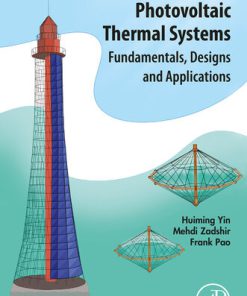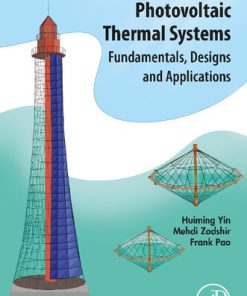Photovoltaic Thermal Passive House System 1st Edition by Gopal Nath Tiwari, Neha Gupta ISBN 9781138333550 1138333557
$50.00 Original price was: $50.00.$25.00Current price is: $25.00.
Photovoltaic Thermal Passive House System 1st Edition by Gopal Nath Tiwari, Neha Gupta – Ebook PDF Instant Download/Delivery: 9781138333550 ,1138333557
Full download Photovoltaic Thermal Passive House System 1st Edition after payment

Product details:
ISBN 10: 1138333557
ISBN 13: 9781138333550
Author: Gopal Nath Tiwari, Neha Gupta
Photovoltaic Thermal Passive House System 1st Edition Table of contents:
1 General Introduction
1.1 Zero Energy Buildings
1.2 The Sun and the Earth
1.2.1 The Sun
1.2.2 The Earth
1.2.3 Sun–Earth Angles
1.2.4 Solar Radiation
1.3 Climate
1.3.1 Climatic Conditions
1.3.2 Weather Conditions
1.3.3 Macro- and Microclimate
1.4 Passive Houses
1.4.1 Strategies for Passive Design
1.5 Architectural Design of Passive Buildings
1.5.1 Site Planning
1.5.2 Envelope Design or Building Envelope
1.5.3 Interior Design
1.6 Bioclimatic Design
1.6.1 History [25]
1.6.2 Building Design Strategies Depending on Climatic Conditions
1.7 Energy Conservation
1.7.1 Introduction
1.7.2 Energy Consumption [29, 30]
1.7.3 Energy Efficiency
1.8 Design Approach to ZEB [32]
1.8.1 Stage 0: Research [33, 34]
1.8.2 Stage 1: Reduce
1.8.3 Stage 2: Reuse
1.8.4 Stage 3: Produce
1.9 Case Study of an Energy Neutral Building [37, 38]
Objective Questions
Answers
Problems
References
2 Basic Heat Transfer
2.1 Introduction
2.2 Conduction
2.2.1 Temperature Field
2.2.2 Fourier’s Heat Conduction Equation
2.2.3 Thermal Conductivity
2.2.4 Thermal Diffusivity
2.2.5 Conductive Heat Transfer Coefficient
2.2.6 Dimensionless Heat Conduction Parameters
2.3 Convection
2.3.1 Dimensionless Heat Convection Parameters
2.3.2 Types of Convection
2.4 Convective Heat Transfer Coefficient
2.5 Radiation
2.5.1 Radiation Involving Real Surfaces
2.5.2 Kirchhoff’s Law
2.5.3 Laws of Thermal Radiation
2.5.4 Radiative Heat Transfer Coefficient
2.6 Evaporation (Mass Transfer)
2.7 Total Heat Transfer Coefficient
2.8 Overall Heat Transfer Coefficient
2.8.1 Parallel Slabs [5]
2.8.2 Parallel Slabs with Air Cavity [5]
2.9 Thermal Circuit Analysis
2.9.1 Composite Wall
2.9.2 Composite Roof
2.10 Energy balance [19]
2.10.1 Energy Balance for Winter’s Day
2.10.2 Energy Balance on a Cloudy Day
2.10.3 Energy Balance on a Summer’s Day in an Air-Conditioned Building
2.10.4 Energy Balance for Intermediate Season Like Spring and Autumn
Objective Questions
Answers
Problems
References
3 Thermal Comfort
3.1 Introduction
3.2 Physical Aspects
3.2.1 Air Temperature
3.2.2 Relative Humidity
3.2.3 Air Movement
3.2.4 Mean Radiant Temperature
3.2.5 Air Pressure
3.2.6 Air Ingredients
3.2.7 Air Electricity
3.2.8 Acoustics
3.2.9 Daylighting
3.3 Physiological Aspects
3.3.1 Nutritional Intake
3.3.2 Age
3.3.3 Ethnic Influences
3.3.4 Gender Differences
3.3.5 Constitution
3.4 Behavioral Aspects
3.4.1 Clothing
3.4.2 Activity Level
3.4.3 Adaptation and Acclimatization
3.4.4 Time of the Day/Season
3.4.5 Occupancy
3.4.6 Psychological Factors
3.5 The Comfort Equation
3.5.1 Conduction
3.5.2 Convection
3.5.3 Radiation
3.5.4 Evaporation
3.5.5 Respiration
3.6 Thermal Comfort Indices
3.6.1 Predicted Mean Vote (PMV) Index
3.6.2 Predicted Percentage Dissatisfied (PPD) Index
3.6.3 Adaptive Comfort Standard
3.6.4 Visual Comfort
3.7 Building Performance Parameters
3.7.1 Thermal Load Leveling (TLL)
3.7.2 Decrement Factor
3.8 Related Standards
Objective Questions
Answers
References
4 Energy and Exergy Analysis
4.1 Introduction
4.1.1 Brief History of Thermodynamics
4.2 Laws of Thermodynamics
4.2.1 The Zeroth Law of Thermodynamics
4.2.2 The First Law of Thermodynamics
4.2.3 The Second Law of Thermodynamics
4.2.4 The Third Law of Thermodynamics
4.3 Energy Analysis
4.3.1 Introduction
4.3.2 Energy Matrices
4.3.3 Embodied Energy Analysis
4.3.4 Energy Density Analysis
4.3.5 An Overall Thermal Energy
4.3.6 Energy Production Factor (EPF)
4.3.7 Life Cycle Conversion Efficiency (LCCE)
4.3.8 Energy Matrices of Photovoltaic (PV) Module
4.4 Exergy Analysis
4.4.1 Low-grade and High-grade Energy
4.4.2 Exergy Efficiency
4.4.3 Solar Radiation Exergy
4.4.4 Exergy Analysis of Photovoltaic Thermal (PVT) Systems
4.5 Case Study with Roof-Mounted BiPVT System
4.5.1 Description
4.5.2 Overall Embodied Energy, EPBT, EPF
Objective Questions
Answers
Problems
References
5 Solar Cell Materials, PV Modules and Arrays
5.1 Introduction
5.2 Basics of Semiconductors and Solar Cells
5.2.1 Intrinsic Semiconductor
5.2.2 Non-Intrinsic Semiconductor
5.2.3 Fermi Level in Semiconductor
5.2.4 p-n Junction
5.2.5 Photovoltaic Effect
5.2.6 Solar Cell (Photovoltaic) Materials
5.2.7 Basic Parameters of Solar Cells
5.3 Photovoltaic (PV) Modules and PV Arrays
5.3.1 Single-Crystal Solar Cells PV Module
5.3.2 Thin-Film PV Modules
5.3.3 Packing Factor (βc) of PV Module
5.3.4 Efficiency of PV Modules
5.3.5 Energy Balance Equations for PV Modules
5.3.6 Series and Parallel Combination of PV Modules
5.3.7 Degradation of Solar Cell Materials [32]
Objective Questions
Answers
References
6 Static Design Concept for a Light-Structured Building for Cold Climatic Conditions
6.1 Introduction
6.2 Sol-air Temperature
6.2.1 Bare Surface
6.2.2 Wetted Surface
6.2.3 Blackened and Glazed Surface
6.3 Thermal Gain
6.3.1 Direct Gain
6.3.2 Indirect Gains
6.3.3 Isolated Gain
6.3.4 Direct and Indirect Gain through Photovoltaic Thermal (PVT) Systems Integrated with Building
Objective Questions
Answers
References
7 Dynamic Design Concepts for Hot Climatic Conditions
7.1 Introduction
7.2 Phase Change Materials (PCMs)
7.3 Infiltration/Natural Ventilation
7.3.1 Smart Windows
7.3.2 Literature Study: Infiltration/Natural Ventilation
7.3.3 Shading
7.3.4 Windows
7.3.5 Walls
7.4 Literature Study: Shading
7.5 Thermotropic and Thermochromic Coatings
7.6 Courtyards
7.7 Air Cavities
7.7.1 Literature Study: Air Cavity
7.8 Green Roofs/Cool Roofs
7.8.1 Literature Study: Cool Roof
7.8.2 Evaporative Cooling
7.8.3 Literature Study: Evaporative Cooling
7.9 Radiative Cooling
7.9.1 Literature Study: Radiative Cooling
7.10 Movable Insulation
7.11 Dynamic Insulation Walls
7.11.1 Exterior Insulation
7.11.2 Interior Insulation
7.12 Wind Towers
7.12.1 Literature Study: Wind Towers
7.13 Air Vents [12]
7.14 Rock Bed Regenerative Cooler
7.15 Earth Coupling
7.15.1 Earth-Air Heat Exchanger (EAHE)
7.16 Roof Pond
7.16.1 Literature Study: Roof Pond-Passive Cooling
7.16.2 Trombe Walls
7.17 Different Compositions of Trombe Wall
7.17.1 Vented Trombe Wall
7.17.2 Phase Change Material (PCM) Trombe Wall
7.17.3 Photovoltaic Integrated Phase Change Materials (PV-PCM) Wall
7.17.4 Heat Transfer in Trombe Walls
7.17.5 Efficiency Analysis of Trombe Wall [88]
7.18 Solar Cooling
7.18.1 Solar Photovoltaic Cooling
Objective Questions
Answers
Problems
References
8 Building Integrated Photovoltaic Thermal Systems (BiPVT)
8.1 Introduction
8.2 Literature Review of BiPV/BiPVT Systems
8.3 Types of PV Integrations with Buildings
8.3.1 Rooftop
8.3.2 Façade
8.3.3 Other Applications
8.4 Building Integrated Opaque Photovoltaic Systems (BiOPV)
8.4.1 Opaque Photovoltaic System Integrated with Rooftop
8.4.2 Opaque Photovoltaic System Integrated with Façade
8.5 Building Integrated Semi-transparent Photovoltaic (BiSPVT) System
8.5.1 Semi-transparent Photovoltaic System Integrated with Rooftop
8.5.2 Facade-Building Integrated Semi-Transparent Photovoltaic (BiSPVT) System
8.6 BiOPVT and BiSPVT System on Rooftop and Façade
8.7 Use of PV Modules in AN Urban Settings
8.8 Energy and Exergy Analysis of BiSPVT System
8.8.1 Working Principle
8.8.2 Thermal Modeling
8.8.3 Basic Energy Balance Equations
8.8.4 Comparative Statement of Proposed Cases (a-d)
8.9 Performance Evaluation of the Proposed Systems
8.9.1 For BiSPVT System (Case a)
8.9.2 For BiSPVT System with Water Flow (Case b)
8.9.3 For BiSPVT System with Heat Capacity (Case c)
8.9.4 For BiSPVT System with Heat Capacity and Water Flow (Case d)
8.9.5 BiSPVT System Heat Capacity with Movable Insulation and South-Facing Window (Case e) [71]
8.10 Input Variables of BiSPVT System: Case Studies
8.10.1 Number of Air Changes
8.10.2 Velocity of the System
8.10.3 Packing Factor
8.10.4 Relative Humidity
8.10.5 Transmissivity of Glass
8.10.6 Mass of Water
8.10.7 Mass Flow Rate
8.11 BiSPVT System Based on the PV Cell Type
8.11.1 Literature Study
8.11.2 Performance of BiSPVT System Based on PV Types: A Case Study
Objective Questions
Answers
References
9 Environmental Aspects
9.1 Introduction
9.2 Life Cycle Assessment
9.2.1 Basic Definitions of Life Cycle Assessment [7]
9.2.2 The Main Stages of Life Cycle Assessment
9.3 Embodied Energy
9.3.1 Embodied Energy of Different Materials
9.3.2 Embodied Energy of Different Construction Materials
9.3.3 Embodied Energy in Floor/Roofing Systems
9.3.4 Embodied Energy in Transportation of Building Materials
9.3.5 Embodied Energy of PV Module [12]
9.3.6 Embodied Energy and Annual Output of Renewable Energy Technologies
9.3.7 Guidelines for Reducing Embodied Energy
9.4 Modeling of Embodied Energy for BiPVT Systems [1]
9.4.1 Masonry Building
9.4.2 Photovoltaic Thermal (PVT) System
9.4.3 Balance of System (BOS)
9.5 Embodied Carbon
9.5.1 Example of Estimation of Embodied Carbon Dioxide for Concrete [21]
9.6 Carbon Dioxide Emissions
9.7 Earned Carbon Credits and Carbon Dioxide Mitigation [1]
9.7.1 Formulation
9.8 Case Study with the BiPVT System
9.9 Kyoto Protocol and the United Nations Framework Convention on Climate Change
9.9.1 The Protocol and the Green Growth
9.10 Carbon Dioxide Mitigation with Use of Photovoltaics
Objective Questions
Answers
References
10 Life Cycle Analysis
10.1 Introduction
10.2 Cash Flow Diagram
10.3 Cost Analysis
10.3.1 Capital Recovery Factor
10.3.2 Uniform Annual Cost
10.3.3 Sinking Fund Factor
10.3.4 Linear Gradient Series Present Value Factor
10.3.5 Gradient to Equal Payment Series Conversion Factor
10.3.6 Linear Gradient Series Future Value Factor
10.4 Capitalized Cost
10.5 Cost Comparisons with Equal Duration
10.6 Net Present Value (NPV)
10.6.1 Limitations of the NPV Method
10.7 Cost Comparisons with Unequal Duration
10.7.1 Single Present Value Method (Method I)
10.7.2 Annual Cost Method (Method II)
10.7.3 Capitalized Cost Method (Method III)
10.7.4 Method IV
10.8 Payback Time
10.8.1 Analytical Expression for Payback Time
10.8.2 Payback Period without Interest
10.8.3 Payback Period with Interest
10.9 Benefit–cost Analysis
10.9.1 Types of Benefit–Cost Analysis
10.9.2 Advantages and Disadvantages of B/C Ratio
10.10 Internal Rate of Return
10.10.1 Iterative Method to Compute IRR [1, 3]
10.10.2 Multiple Values of IRR [1, 3]
10.11 Effect of Depreciation [2, 5, 6]
10.11.1 Expression for Book Value
10.11.2 Straight-Line Depreciation [2]
10.11.3 Sinking Fund Depreciation
10.11.4 Accelerated Depreciation
10.12 Cost Comparison after Taxes
10.12.1 Without Depreciation
10.12.2 With Depreciation
10.13 Estimating Cost of a Project [1]
10.13.1 Capital Cost
10.13.2 Variable Cost
10.13.3 Step-variable Cost
10.13.4 Non-Product Cost
10.14 A Case Study of Building Integrated Photovoltaic Thermal (BiPVT) Systems
10.14.1 Cost Estimation [1]
10.14.2 Modeling of Annualized Uniform Cost
10.14.3 Methodology [1]
10.14.4 Results and Discussions [1]
Objective Questions
Answers
Problems
References
11 Photovoltaic Application in Architecture
11.1 Introduction
11.2 Implementation of PV Systems around the World
11.2.1 China
11.2.2 United States of America
11.2.3 Japan
11.2.4 Germany
11.2.5 India
11.2.6 Spain
11.3 Case Study: BiSPVT System Installed at Sodha Bers Complex, Varanasi, India [51]
11.3.1 Introduction and Planning
11.3.2 Zones [51]
11.3.3 Construction Details and Materials Used [52]
11.3.4 Thermal Heat Gains [51]
11.3.5 Electrical Power (Ep)
11.3.6 Daylight Energy Savings
11.3.7 Total Energy Savings
11.3.8 Embodied Energy
11.3.9 Energy Payback Time (EPBT)
11.3.10 Energy Production Factor (EPF)
11.3.11 Life Cycle Conversion Efficiency
11.3.12 Carbon Dioxide Emission
11.3.13 Net Carbon Dioxide Mitigation
11.3.14 Earned Carbon Credits
People also search for Photovoltaic Thermal Passive House System 1st Edition:
3 bedroom passive solar house plans
what is a passive solar heating system
pv thermal panels
is passive solar heating based on the greenhouse effect
is passive solar worth it
Tags: Gopal Nath Tiwari, Neha Gupta, Photovoltaic, Thermal Passive House
You may also like…
Computers - Algorithms and Data Structures
Physics - Mechanics: Nonlinear dynamics and chaos
Uncategorized
Politics & Philosophy - Anthropology
Business & Economics - Personal Finance











